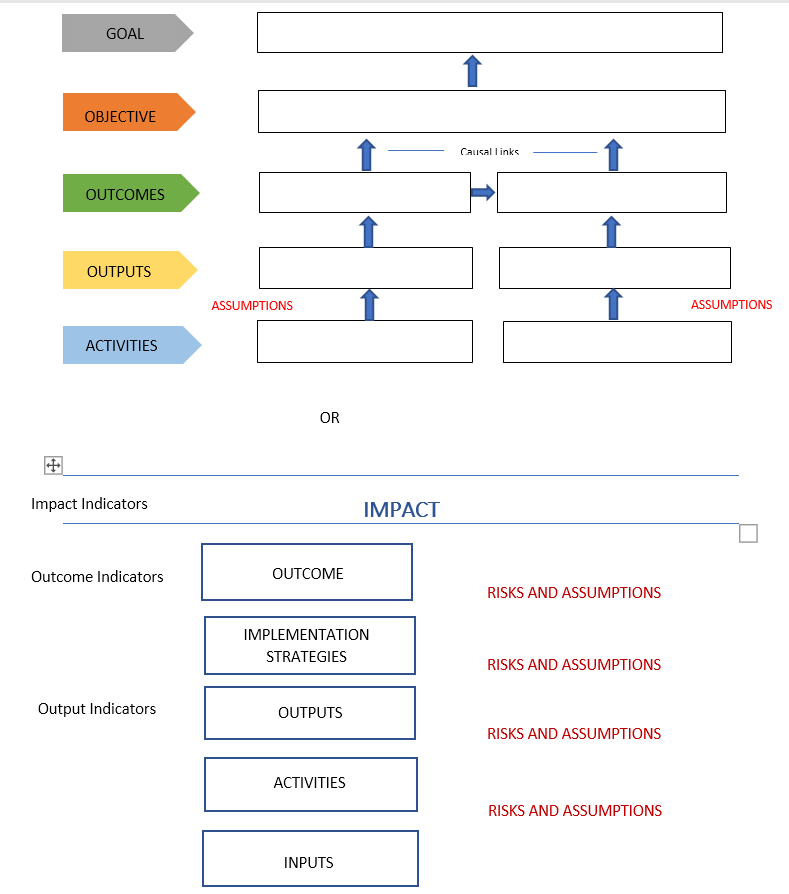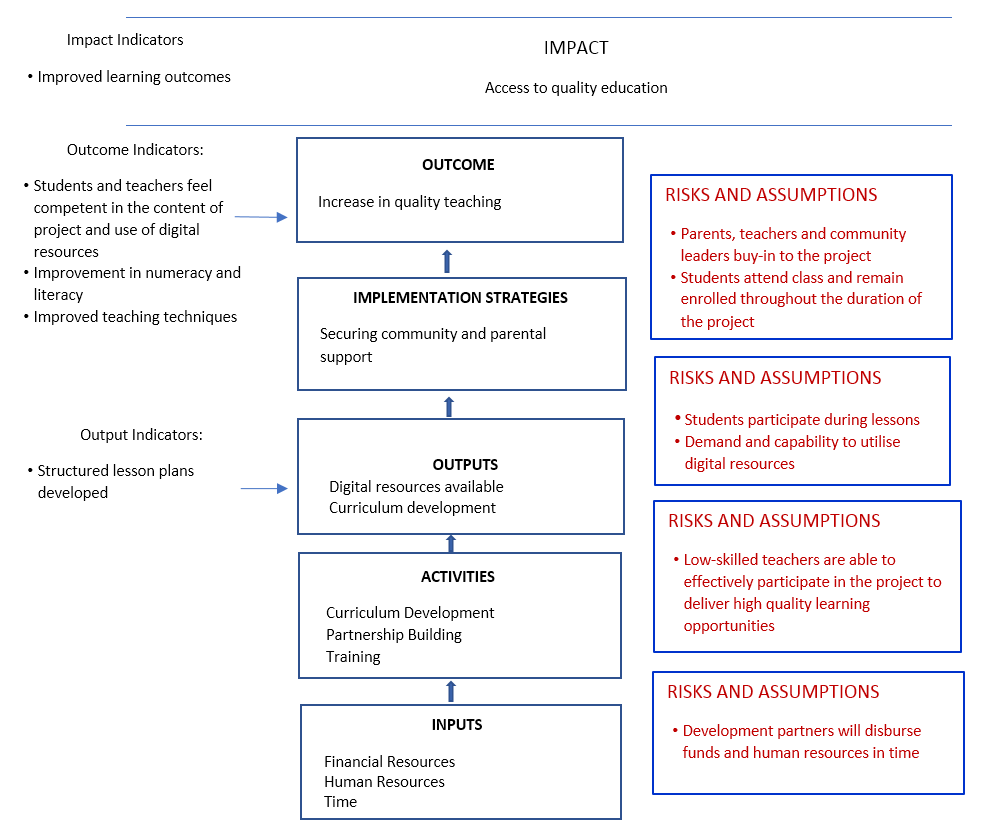Theory of Change
Written by Sahar Mohy-Ud-Din, OAD fellow
Developmental projects follow a logical process of reasoning from the conception and design phase of a project to the implementation and outcome phase in order to achieve the desired goal of the project. Theory of Change commonly abbreviated to TOC, is essentially a comprehensive description of how and why a desired change is expected to happen in a particular context/project. A key defining feature of a theory of change is the presentation of the link between outcomes and activities to explain HOW and WHY the desired change is expected to come about. Its main focus is on mapping out or “filling in” what has been described as the “missing middle” between what a program or change initiative does (its activities or interventions) and how these lead to desired goals being achieved. It does this by first recognizing the desired long-term goals and then works back from these to identify all the conditions (outcomes) that must be in place (and how these related to one another causally) for the goals to occur. The theory of change is outcomes based following a causal model which clearly articulates underlying assumptions. Sometimes the term is used generally to refer to any version of this process, including a results chain, which shows a series of boxes from inputs to outputs, outcomes and impacts, or a logframe, which represents the same information in a matrix (Rogers, 2014: 1). The focus on the TOC is really on causality and ensuring that logical thought guides the process in delivering an effective project.
Steps to Create a Theory of Change
1. Identifying long-term goals
2. Backwards mapping and connecting the preconditions or requirements necessary to achieve that goal and explaining why these preconditions are necessary and sufficient.
3. Identifying your basic assumptions about the context.
4. Identifying the interventions that your initiative will perform to create your desired change.
5. Developing indicators to measure your outcomes to assess the performance of your initiative.
6. Writing a narrative to explain the logic of your initiative.
While the diagram below is similar to a logframe, it is depicting the whole picture involved in implementing the project using a Theory of Change in a neat and concise manner. Another depiction of the Theory of Change is also presented below.
A theory of change can be graphically represented in a number of ways such as that illustrated below:
2. Key terminology in understanding the building blocks of the Theory of Change
Goal
This refers to the overarching purpose of your project. It is a broad statement of what the project seeks to addresses (i.e. either at the national or sectoral level) and is difficult to measure. A goal implies a relatively broad and distant outcome and is usually synonymous with “impact.”
Objective
Objectives are specific, precise, tangible and measurable stepping stones towards the achievement of the goal. They capture what is planned to be done as well as what is planned to be achieved. Indicators measure the extent of the achievement of the project’s objective.
Outcome
This refers to the changes, benefits, learning or other effects that happen as a result of your project. It also includes the intended and unintended consequences of the project. They should be comprehensive enough to reflect the complexity of the programme – their aim is to explain in detail all of the changes that happen to beneficiaries during the programme.
The outcomes can be immediate, intermediate or longer term. It is likely that you will have a number of outcomes along a chain to get to your final aim. You will need to ensure that the earlier outcomes on the chain take place before it is possible that the later ones can do.
Outcomes should be specific and measurable, typically using language such as ‘greater’, ‘improved’ or ‘increased’. They should be phrased as if they have been achieved already.
Output
Outputs refer to activities, events, products or services that reach people who participate or are beneficiaries of the project.
Activities
Activities are what you do during the project to achieve the goal, such as the specific services you deliver, workshops hosted, training provided or skills gained through your project. Activities should be sufficiently detailed, so that someone unfamiliar with the programme can understand what each activity entails.
Causal Links
The Theory of Change will include arrows which explain the causality of your project in more detail. More specifically, causal links should show which activities lead to which outcomes, which outcomes lead to which other outcomes, and which outcomes lead to which aim/objective(s) (if there is more than one aim/objective).
Causal links should reflect the complexity and dynamism of the programme – generally speaking it is likely that some activities will lead to more than one outcome, some outcomes will have more than one activity leading to them, and many outcomes will lead to other outcomes.
However, complexity should also be balanced with clarity – if the number and complexity of causal links are making the Theory of Change difficult to follow or digest, you should consider removing some of the less integral causal links from the diagram. Every activity and outcome should eventually link to at least one of your aims.
Assumptions
Assumptions help to explain the Theory of Change process and the connections between the measurable effects, wider benefits and the longer-term goal, as well as how and why proposed activities are expected to bring these changes about.
The purpose of assumptions is to proactively identify reasons why some of your causal links may not hold true in practice. Ask yourself, for each activity-outcome pair: What assumptions have been made in determining this relationship? Assumptions should focus on your most contestable causal links i.e. the sections of your Theory of Change that someone might challenge as being less plausible or convincing.
*Indicators
The success of any Theory of Change lies in the ability to demonstrate progress on the achievement of outcomes. Therefore, the outcomes in a Theory of Change must be coupled with indicators that allow measurement to determine the extent to which progress has been made.
Indicators operationalize the outcomes––that is, they reduce the outcomes to concrete, observable and/or measurable terms. Ideally, every outcome should have an indicator, but available resources often make that difficult to do.
Narrative
The narrative is a summary of the theory that explains the overall logic, highlights major assumptions, and presents a compelling case as to how and why the initiative is expected to work. The purpose of the narrative is twofold: (1) to convey the major elements of the theory easily and quickly to others; (2) to communicate how the elements of the theory work as a whole. The narrative is natural companion to the visual elements of the theory as they reinforce each other.
3. General Features of the Theory of Change
When developing a Theory of Change, it is vital to understand the landscape in which the project will be executed. Key points to remember when developing a TOC are:
1. The actors (individuals or groups) who are trying to bring about change
2. The context or situation that influences the actors and which they are trying to change;
3. The ideas or theories that influence the actors when they consider how to act in a certain situation at a situation;
4. The strategic plan that describes the reasons and provides a framework for taking particular action; and
5. The reflection and decision-making processes that help actors to develop strategy, review success and failure and make improvements to ideas and strategies.
These pointers help flesh out the outcome and output levels of the TOC effectively.
A Theory of Change provides the big picture, including issues related to the environment or context that can’t be controlled.
Shows all the different pathways that might lead to change, even if those pathways are not related to the project.
Describes how and why you think change happens.
Could be used to complete the sentence “if we do X, then Y will change because…” This helps in determining the causal links.
Is presented as a diagram with narrative text.
The diagram is flexible and doesn’t have a particular format—it can include cyclical processes, feedback loops, one box could lead to multiple other boxes, different shapes could be used, etc.
Describes why you think one box will lead to another box (e.g., if you think increased knowledge will lead to behaviour change, is that an assumption or do you have evidence to show it is the case?)
Final checklist
□ Does your Theory of Change have a title which includes the name of the project?
□ Does your Theory of Change include activities, outcomes, causal links, assumptions and one or more aims/objectives?
□ Are each of those elements colour-coded and labelled?
□ Does your Theory of Change make it clear who the target population is?
□ Does your Theory of Change describe the ‘dosage’ of the activities i.e. how much of the activities each beneficiary receives?
□ Does your Theory of Change avoid referring to training, referral routes, marketing, programme setup or any other operational activities?
□ Are all of your outcomes and aims measurable?
□ Are some of your outcomes connected to each other by causal links? (i.e. all of the outcomes don’t lead directly to the aim)
□ Are all of your causal links visually clear and easy to follow on the page?
□ Is every item connected to at least one of your aims/objectives?
□ Do all of the causal pathways make sense?
□ Are all of your assumptions sitting on specific causal links? Each assumption should relate to a specific causal pathway: there should not be general project assumptions floating around.
□ Is the project’s objective achievable within the timeframe and resources available for this project? If not, revise the objective.
□ Does the narrative highlight and describe the overall logic of the intervention and the
key hypotheses which the programme is based on?
Example
Astronomy for Literacy (AFL)
Astronomy for Literacy (AFL) will work to enhance literacy, numeracy and other foundational skills among up to 1250 struggling junior secondary school students in Sierra Leone. It will do this by adapting and developing high quality curriculum resources across literacy, math and science. The goal will be to use astronomy-related content to teach foundational reading and numeracy skills, while at the same time igniting an interest in astronomy and teaching in an engaging way the core concepts in astronomy that are part of Sierra Leone’s national curriculum for science.
The primary deliverables will be detailed, highly structured lesson plans that enable relatively low-skilled teachers with limited subject knowledge to still deliver high quality learning opportunities. Alongside this, the project will also invest in finding appropriate supplementary digital resources, including videos, presentations and other offline content, and in low-cost tablet devices that will allow groups of students to access this content.
4. References:
Clark, H. and Anderson, A. 2004. Theories of Change and Logic Models: Telling Them Apart. Available at: https://www.theoryofchange.org/wp-content/uploads/toco_library/pdf/TOCs_and_Logic_Models_forAEA.pdf
Rogers, P. 2014. Theory of Change, Methodological Briefs: Impact Evaluation 2. Available at: http://devinfolive.info/impact_evaluation/img/downloads/Theory_of_Change_ENG.pdf
Vogel, I. 2012. Review of the use of ‘Theory of Change’ in international development. Available at: https://assets.publishing.service.gov.uk/media/57a08a5ded915d3cfd00071a/DFID_ToC_Review_VogelV7.pdf


